The trans-zeatin riboside market is forecast to grow from USD 142.5 million in 2025 to USD 322.2 million by 2035 at a CAGR of 8.5%, driven by expanding demand for high purity cytokinin formulations across university laboratories, agricultural research centers, and specialized biotechnology applications. Early phase gains to 2030 will be supported by adoption of Purity greater than 97% grades, cost declines from synthesis optimization, and standardization of experimental protocols, while the latter phase through 2035 will be characterized by wider deployment of automated dispensing, integration with laboratory management systems, and expanded agricultural field trial applications. Market segmentation is dominated by high purity systems at approximately 62% share, with standard purity systems retaining a meaningful position for cost sensitive use cases.
Biomedical and agricultural research funding flows are being captured as core demand drivers, with Asia Pacific identified as a principal growth region where China and India exhibit double digit CAGR projections owing to research capacity additions and localized production strategies. Supply side competition centers on synthesis capability, purity control, and analytical verification services, where leading biochemical suppliers maintain advantage through validated quality systems and integrated channel partnerships. Adoption barriers include synthesis cost variability and stability constraints for long term storage and field deployment, which are being addressed through formulation improvements and cold chain practices in select segments.

The latter half (2030-2035) will witness sustained growth from USD 197.5 million to USD 322.2 million, representing an addition of USD 124.7 million or 69.4% of the decade's expansion. This period will be defined by mass market penetration of specialized high-purity designs, integration with comprehensive research platforms, and seamless compatibility with existing laboratory infrastructure. The market trajectory signals fundamental shifts in how researchers approach plant hormone optimization and experimental quality management, with participants positioned to benefit from sustained demand across multiple purity levels and research application segments.
The Trans-zeatin Riboside market demonstrates distinct growth phases with varying market characteristics and competitive dynamics. Between 2025 and 2030, the market progresses through its technology adoption phase, expanding from USD 142.5 million to USD 197.5 million with steady annual increments averaging 8.5% growth. This period showcases the transition from basic cytokinin formulations to advanced high-purity systems with enhanced research capabilities and integrated quality control systems becoming mainstream features.
The 2025-2030 phase adds USD 55 million to market value, representing 30.6% of total decade expansion. Market maturation factors include standardization of plant research and biotechnology protocols, declining synthesis costs for specialized cytokinin formulations, and increasing scientific awareness of trans-zeatin riboside benefits reaching optimal experimental effectiveness in university and agricultural research applications. Competitive landscape evolution during this period features established biochemical suppliers like Merck and bioWORLD expanding their cytokinin portfolios while specialty manufacturers focus on advanced purity development and enhanced research-grade capabilities.
From 2030 to 2035, market dynamics shift toward advanced purity integration and global research expansion, with growth continuing from USD 197.5 million to USD 322.2 million, adding USD 124.7 million or 69.4% of total expansion. This phase transition centers on specialized high-purity systems, integration with automated research networks, and deployment across diverse university and agricultural scenarios, becoming standard rather than specialized applications. The competitive environment matures with focus shifting from basic compound capability to comprehensive research optimization systems and integration with laboratory management platforms.
At-a-Glance Metrics
| Metric | Value |
|---|---|
| Market Value (2025) | USD 142.5 million |
| Market Forecast (2035) | USD 322.2 million |
| Growth Rate | 8.5% CAGR |
| Leading Technology | Purity > 97% Purity Level |
| Primary Application | University Laboratories Application Segment |
The market demonstrates strong fundamentals with high-purity systems capturing a dominant share through advanced compound design and research optimization capabilities. University laboratory applications drive primary demand, supported by increasing plant biology research and precision cytokinin technology requirements. Geographic expansion remains concentrated in developed markets with established research infrastructure, while emerging economies show accelerating adoption rates driven by agricultural research expansion and rising scientific standards.
Market expansion rests on three fundamental shifts driving adoption across the university laboratories, agricultural research, and biotechnology sectors. First, plant biology research demand creates compelling operational advantages through trans-zeatin riboside that provides immediate experimental precision and plant hormone control without compromising research goals, enabling scientists to meet stringent quality standards while maintaining research productivity and reducing experimental variability. Second, agricultural research modernization accelerates as institutions worldwide seek advanced cytokinin systems that complement traditional research processes, enabling precise plant growth regulation and experimental control that align with scientific standards and research protocols.
Third, biotechnology advancement drives adoption from pharmaceutical companies and biotech facilities requiring effective plant hormone solutions that maximize research efficiency while maintaining experimental accuracy during compound screening and development operations. However, growth faces headwinds from synthesis cost challenges that vary across biochemical suppliers regarding the sourcing of precursor compounds and purification reagents, which may limit adoption in cost-sensitive research environments. Technical limitations also persist regarding stability considerations and storage complexity concerns that may reduce effectiveness in specialized experimental or field application scenarios, which affect compound performance and handling requirements.
The trans-zeatin riboside market represents a specialized yet critical plant hormone opportunity driven by expanding global plant biology research, agricultural innovation modernization, and the need for superior cytokinin purity in diverse scientific applications. As researchers worldwide seek to achieve optimal experimental accuracy, reduce variability in plant studies, and integrate advanced cytokinin systems with automated platforms, trans-zeatin riboside is evolving from basic research reagent to sophisticated experimental solution ensuring scientific quality and research leadership.
The market's growth trajectory from USD 142.5 million in 2025 to USD 322.2 million by 2035 at an 8.5% CAGR reflects fundamental shifts in plant science requirements and precision cytokinin optimization. Geographic expansion opportunities are particularly pronounced in Asia Pacific markets, while the dominance of high-purity systems and university laboratory applications provides clear strategic focus areas.
Strengthening the dominant purity greater than 97% segment through enhanced synthesis formulations, superior compound quality, and automated purification systems. This pathway focuses on optimizing synthesis protocols, improving purity specifications, extending operational effectiveness to optimal research-grade rates, and developing specialized formulations for diverse applications. Market leadership consolidation through advanced biochemical engineering and automated synthesis integration enables premium positioning while defending competitive advantages against alternative cytokinins. Expected revenue pool: USD 48-65 million
Rapid university research and agricultural science growth across Asia Pacific creates substantial expansion opportunities through local production capabilities and technology transfer partnerships. Growing research facility construction and government science initiatives drive sustained demand for advanced trans-zeatin riboside systems. Localization strategies reduce import costs, enable faster technical support, and position companies advantageously for procurement programs while accessing growing domestic research markets. Expected revenue pool: USD 42-57 million
Expansion within the dominant university laboratory segment (58% market share) through specialized cytokinin designs addressing plant biology research standards and high-volume experimental requirements. This pathway encompasses automated dispensing systems, quality control integration, and compatibility with diverse research processes. Premium positioning reflects superior compound purity and comprehensive scientific compliance supporting modern plant research operations. Expected revenue pool: USD 38-52 million
Strategic expansion into agricultural research center applications (37% market share) requires enhanced cytokinin capabilities and specialized formulations addressing crop improvement operational requirements. This pathway addresses field trial optimization, plant breeding enhancement, and agricultural innovation with advanced synthesis engineering for demanding research standards. Premium pricing reflects specialized purity requirements and extended stability standards. Expected revenue pool: USD 32-44 million
Development of specialized trans-zeatin riboside formulations for other applications (5% share), addressing specific biotechnology requirements and niche research demands. This pathway encompasses pharmaceutical research designs, industrial biotechnology protocols, and cost-effective alternatives for emerging scientific segments. Technology differentiation through proprietary synthesis enables diversified revenue streams while reducing dependency on single application platforms. Expected revenue pool: USD 18-25 million
Expansion of purity equal to or less than 97% segment (35% market share) through cost-optimized synthesis, adequate research-grade properties, and specialized educational requirements. This pathway encompasses teaching laboratory applications, preliminary screening studies, and standard formulations requiring satisfactory cytokinin quality characteristics. Market development through efficient synthesis enables differentiated positioning while accessing cost-sensitive markets requiring reliable but economical plant hormone solutions. Expected revenue pool: USD 28-38 million
Development of scientifically superior trans-zeatin riboside formulations addressing quality standards and research requirements across university and agricultural applications. This pathway encompasses analytical certification integration, standardized research protocols, and comprehensive documentation. Premium positioning reflects scientific leadership and quality expertise while enabling access to research-focused procurement programs and standards-driven institutional partnerships. Expected revenue pool: USD 22-30 million
Primary Classification: The market segments by purity level into Purity > 97%, Purity ≤ 97%, and Others categories, representing the evolution from basic research-grade materials to specialized high-purity solutions for comprehensive experimental optimization.
Secondary Classification: Application segmentation divides the market into University Laboratories, Agricultural Research Centers, and Others sectors, reflecting distinct requirements for compound purity, experimental capacity, and research quality standards.
Regional Classification: Geographic distribution covers Asia Pacific, Europe, North America, and other regions, with developed markets leading adoption while emerging economies show accelerating growth patterns driven by research expansion programs.
The segmentation structure reveals technology progression from standard cytokinin-based formulations toward specialized high-purity systems with enhanced research and quality capabilities, while application diversity spans from university research operations to specialized agricultural and biotechnology applications requiring precise plant hormone solutions.
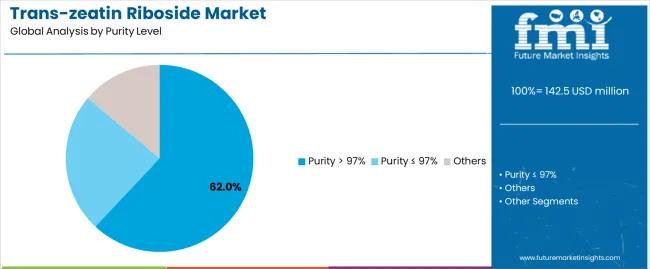
Market Position: High-purity systems command the leading position in the Trans-zeatin Riboside market with approximately 62% market share through advanced synthesis properties, including superior compound clarity, reliable experimental capability, and research optimization that enable scientists to achieve optimal precision across diverse university and agricultural environments.
Value Drivers: The segment benefits from researcher preference for reliable cytokinin systems that provide consistent experimental performance, reduced research errors, and protocol compatibility without requiring significant methodology modifications. Advanced purity features enable automated research integration systems, compound consistency, and compatibility with existing laboratory equipment, where cytokinin performance and experimental reliability represent critical research requirements.
Competitive Advantages: High-purity systems differentiate through proven quality standards, consistent analytical characteristics, and integration with automated research systems that enhance scientific effectiveness while maintaining optimal precision suitable for diverse plant biology applications.
Key market characteristics:
Standard purity systems maintain cost-effective positioning in the Trans-zeatin Riboside market with approximately 35% market share due to their economical synthesis properties and adequate research advantages. These systems appeal to institutions requiring satisfactory cytokinin compounds with acceptable performance for educational and preliminary research applications. Market adoption is driven by teaching laboratory expansion, emphasizing reliable compound solutions and operational efficiency through optimized synthesis systems while maintaining competitive pricing structures.
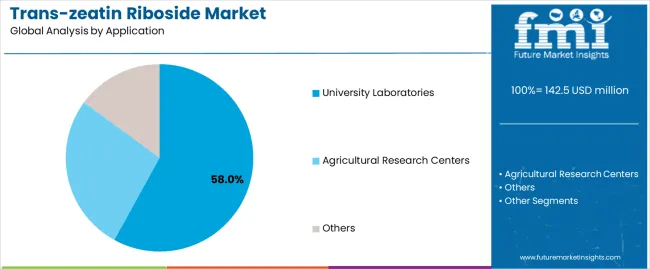
Market Context: University laboratory applications dominate the Trans-zeatin Riboside market with approximately 58% market share due to widespread adoption of plant hormone compounds and increasing focus on experimental precision, research optimization, and plant biology investigation applications that minimize experimental errors while maintaining scientific standards.
Appeal Factors: University researchers prioritize compound reliability, experimental consistency, and integration with existing research infrastructure that enables coordinated cytokinin application across multiple plant studies. The segment benefits from substantial research funding and plant science programs that emphasize the acquisition of high-purity cytokinins for experimental control and scientific discovery applications.
Growth Drivers: Plant biology research expansion programs incorporate trans-zeatin riboside as standard reagent for university operations, while experimental quality requirements increase demand for precision cytokinin capabilities that comply with scientific standards and minimize research variations.
Market Challenges: Varying institutional standards and research protocol differences may limit compound standardization across different university facilities or experimental scenarios.
Application dynamics include:
Agricultural research center applications capture approximately 37% market share through specialized cytokinin requirements in crop improvement research, plant breeding programs, and agricultural innovation applications. These facilities demand robust compound systems capable of field trial applications while providing accurate plant growth regulation and experimental consistency capabilities.
Other applications account for approximately 5% market share, including pharmaceutical research, industrial biotechnology, and specialized scientific investigation applications requiring trans-zeatin riboside capabilities for compound screening and developmental protocols.
Growth Accelerators: Plant biology research expansion drives primary adoption as trans-zeatin riboside provides superior experimental capabilities that enable research institutions to meet stringent scientific standards without excessive reagent costs, supporting research operations and academic missions that require precise plant hormone applications. Research infrastructure demand accelerates market expansion as scientific facilities seek effective precision compounds that minimize experimental errors while maintaining research effectiveness during plant studies and biotechnology scenarios. Research funding increases worldwide, creating sustained demand for cytokinin systems that complement traditional plant science processes and provide experimental optimization in competitive scientific markets.
Growth Inhibitors: Synthesis cost challenges vary across biochemical suppliers regarding the sourcing of precursor compounds and purification reagents, which may limit operational flexibility and market penetration in regions with budget constraints or cost-sensitive research operations. Technical performance limitations persist regarding stability considerations and storage complexity that may reduce effectiveness in specialized field trial, long-term storage, or high-temperature conditions, affecting compound versatility and application requirements. Market fragmentation across multiple scientific standards and research protocols creates compatibility concerns between different supplier specifications and existing laboratory infrastructure.
Market Evolution Patterns: Adoption accelerates in plant biology and agricultural research sectors where experimental precision justifies cytokinin costs, with geographic concentration in developed markets transitioning toward mainstream adoption in emerging economies driven by research expansion and scientific awareness. Technology development focuses on enhanced synthesis formulations, improved stability integration, and compatibility with laboratory information systems that optimize experimental accuracy and research effectiveness. The market could face disruption if alternative cytokinin technologies or synthetic plant hormone innovations significantly limit the deployment of trans-zeatin riboside in research applications, though trans-zeatin riboside's unique combination of natural origin, biological activity, and experimental reliability continues to make it preferred in plant science applications.
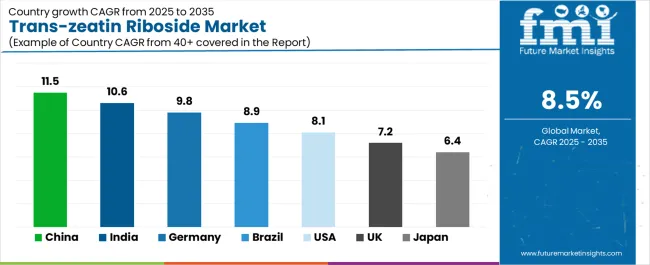
The Trans-zeatin Riboside market demonstrates varied regional dynamics with Growth Leaders including China (11.5% CAGR) and India (10.6% CAGR) driving expansion through research capacity additions and agricultural innovation programs. Steady Performers encompass Germany (9.8% CAGR), Brazil (8.9% CAGR), and United States (8.1% CAGR), benefiting from established research infrastructure and advanced scientific adoption. Mature Markets feature United Kingdom (7.2% CAGR) and Japan (6.4% CAGR), where specialized plant biology applications and precision cytokinin integration support consistent growth patterns.
| Country | CAGR (2025-2035) |
|---|---|
| China | 11.5% |
| India | 10.6% |
| Germany | 9.8% |
| Brazil | 8.9% |
| United States | 8.1% |
| United Kingdom | 7.2% |
| Japan | 6.4% |
Regional synthesis reveals Asia Pacific markets leading adoption through research expansion and agricultural science infrastructure development, while European countries maintain steady expansion supported by precision biochemical technology advancement and quality standardization requirements. North American markets show moderate growth driven by university research applications and scientific integration trends.

The Chinese market emphasizes advanced cytokinin features, including precision experimental control and integration with comprehensive research platforms that manage quality assurance, scientific optimization, and plant biology applications through unified laboratory systems. The country demonstrates strong growth at 11.5% CAGR, driven by university expansion, agricultural research initiatives, and emerging scientific facility development that support trans-zeatin riboside integration. Chinese researchers prioritize experimental effectiveness with trans-zeatin riboside delivering consistent compound performance through advanced synthesis capabilities and research adaptation features.
Technology deployment channels include major university facilities, specialized biochemical suppliers, and research procurement programs that support professional applications for complex plant biology studies and agricultural innovation applications. Research platform integration capabilities with established laboratory systems expand market appeal across diverse scientific requirements seeking experimental precision and automation benefits. The expanding research base and accelerating plant science sector create sustained demand, while innovative applications in crop improvement centers and botanical research facilities open new growth avenues.
Performance Metrics:
Germany's advanced scientific market demonstrates sophisticated trans-zeatin riboside deployment with documented experimental effectiveness in plant biology research applications and agricultural facilities through integration with existing laboratory systems and research infrastructure. The country leverages scientific expertise in precision biochemicals and research systems integration to maintain strong growth at 9.8% CAGR. Research centers, including Berlin, Munich, and Heidelberg, showcase precision installations where trans-zeatin riboside systems integrate with comprehensive research platforms and quality management systems to optimize experimental operations and compound effectiveness.
German researchers prioritize system purity and scientific compliance in cytokinin development, creating demand for advanced compound systems with superior features, including analytical certification and quality assurance systems. The market benefits from established research infrastructure and a willingness to invest in precision biochemical technologies that provide long-term scientific benefits and compliance with international quality and research standards.
Market Intelligence Brief:
The USA research trans-zeatin riboside market demonstrates sophisticated deployment across university applications with documented effectiveness in plant biology studies and agricultural research facilities through integration with comprehensive laboratory systems and quality control infrastructure. The country leverages advanced research capabilities in scientific innovation and experimental technologies to maintain moderate growth at 8.1% CAGR. Research centers, including Boston, San Diego, and Ithaca, showcase advanced installations where trans-zeatin riboside systems integrate with comprehensive research platforms and university management networks to optimize scientific efficiency and experimental accuracy.
American researchers prioritize scientific innovation and experimental precision in cytokinin development, creating demand for advanced compound systems with superior features, including automated dispensing integration and analytical tracking systems. The market benefits from established research infrastructure and willingness to invest in innovation technologies that provide long-term scientific benefits and compliance with research and quality standards.
Market Intelligence Brief:
The UK research trans-zeatin riboside market demonstrates advanced quality deployment with documented experimental effectiveness in plant biology research applications and agricultural facilities through integration with existing quality systems and research infrastructure. The country leverages regulatory expertise in scientific standards and research systems integration to maintain steady growth at 7.2% CAGR. Research centers, including Cambridge, Oxford, and Edinburgh, showcase precision installations where trans-zeatin riboside systems integrate with comprehensive quality platforms and laboratory management systems to optimize scientific compliance and experimental effectiveness.
British researchers prioritize system quality and regulatory compliance in cytokinin development, creating demand for certified compound systems with advanced features, including traceability tracking and quality integration. The market benefits from established research infrastructure and commitment to invest in quality technologies that provide long-term scientific benefits and compliance with UK and EU research standards. Plant biology applications, agricultural research systems, and botanical programs drive diversified demand across multiple research segments.
Strategic Market Indicators:
India's research trans-zeatin riboside market demonstrates rapid expansion deployment with documented experimental effectiveness in plant biology research applications and university facilities through integration with emerging research systems and scientific infrastructure. The country leverages growing research capabilities in agricultural science and laboratory systems integration to achieve high growth at 10.6% CAGR. Research centers, including Bangalore, Delhi, and Mumbai, showcase expanding installations where trans-zeatin riboside systems integrate with comprehensive research platforms and university networks to optimize market penetration and experimental effectiveness.
Indian researchers prioritize experimental precision and scientific standards in cytokinin development, creating demand for reliable compound systems with advanced features, including automated integration and quality control systems. The market benefits from expanding research infrastructure and willingness to invest in international-standard biochemical technologies that provide scientific optimization and compliance with global research standards.
Market Intelligence Brief:
Japan's research trans-zeatin riboside market demonstrates precision deployment with documented experimental effectiveness in advanced plant biology research applications and specialized scientific facilities through integration with sophisticated laboratory systems and quality infrastructure. The country leverages scientific excellence in precision biochemicals and research systems integration to maintain steady growth at 6.4% CAGR. Research centers, including Tokyo, Kyoto, and Osaka, showcase precision installations where trans-zeatin riboside systems integrate with comprehensive quality platforms and research management systems to optimize experimental excellence and compound effectiveness.
Japanese researchers prioritize system precision and scientific excellence in cytokinin development, creating demand for ultra-high-purity compound systems with advanced features, including analytical verification capabilities and quality integration systems. The market benefits from established research infrastructure and commitment to invest in highest-quality biochemical technologies that provide superior experimental performance and compliance with stringent Japanese research standards.
Strategic Market Indicators:
Brazil's research trans-zeatin riboside market demonstrates expanding deployment with documented experimental effectiveness in plant biology research applications and agricultural facilities through integration with developing research systems and scientific infrastructure. The country leverages research growth capabilities in agricultural science expansion and laboratory systems development to achieve growth at 8.9% CAGR. Research centers, including Sao Paulo, Brasilia, and Campinas, showcase growing installations where trans-zeatin riboside systems integrate with research platforms and agricultural operations to optimize scientific development and experimental effectiveness.
Brazilian researchers prioritize experimental reliability and cost-effectiveness in cytokinin development, creating demand for dependable compound systems with practical features, including research integration and quality monitoring systems. The market benefits from expanding research infrastructure and investment in scientific technologies that provide experimental improvement and compliance with emerging research standards.
Market Intelligence Brief:
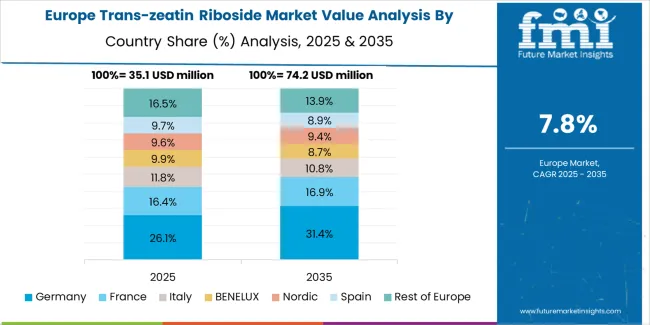
The Trans-zeatin Riboside market in Europe is projected to grow substantially over the forecast period, with Germany expected to maintain its leadership position with a significant market share supported by its advanced research infrastructure and major scientific centers in Berlin and Munich. United Kingdom follows with strong market presence, driven by comprehensive plant biology programs and precision research initiatives. France holds substantial market share through specialized botanical activities, university research applications, and scientific facility expansion. Italy commands notable market presence through strong agricultural research and university projects. Spain accounts for growing market share aided by research expansion and scientific adoption. The Netherlands maintains steady share driven by specialty biotechnology applications and laboratory automation demand. The Rest of Europe region is anticipated to show steady adoption, reflecting consistent growth in Nordic countries, research expansion in Central European markets, and scientific upgrades across Eastern European university facilities.
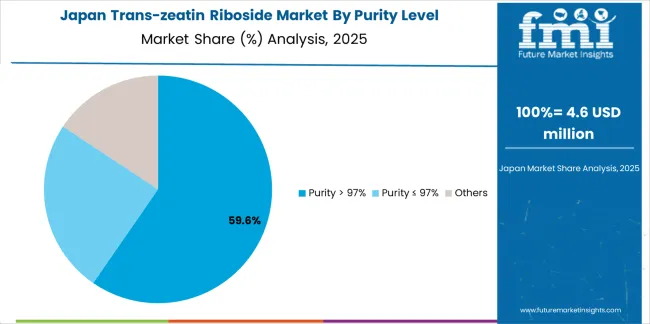
In Japan, the Trans-zeatin Riboside market prioritizes high-purity systems, which capture the dominant share of plant biology research and university installations due to their advanced features, including precision synthesis optimization and seamless integration with existing research infrastructure. Japanese researchers emphasize reliability, purity, and long-term experimental excellence, creating demand for high-purity systems that provide consistent cytokinin capabilities and superior compound performance based on scientific requirements and quality standards. Standard purity maintains secondary positions primarily in educational laboratory applications and preliminary screening installations where adequate compound functionality meets operational requirements without compromising experimental reliability.
Market Characteristics:

In South Korea, the market structure favors international biochemical suppliers, including Merck, bioWORLD, and PhytoTech Labs, which maintain dominant positions through comprehensive product portfolios and established research networks supporting both university laboratory and agricultural research installations. These providers offer integrated solutions combining advanced trans-zeatin riboside systems with professional analytical services and ongoing technical support that appeal to Korean institutions seeking reliable precision cytokinin systems. Local laboratory distributors and scientific service providers capture moderate market share by providing localized service capabilities and competitive pricing for standard compound installations, while domestic suppliers focus on specialized applications and cost-effective solutions tailored to Korean research market characteristics.
Channel Insights:

The Trans-zeatin Riboside market operates with moderate concentration, featuring approximately 16-18 meaningful participants, where leading companies control roughly 38-43% of the global market share through established research relationships and comprehensive biochemical portfolios. Competition emphasizes advanced synthesis capabilities, compound purity, and research integration rather than price-based rivalry. The leading company, Merck, commands approximately 16% market share through its extensive plant hormone product line and global research presence.
Market Leaders encompass Merck, bioWORLD, and PhytoTech Labs, which maintain competitive advantages through extensive cytokinin synthesis expertise, global research networks, and comprehensive quality integration capabilities that create customer loyalty and support premium pricing. These companies leverage decades of biochemical experience and ongoing innovation investments to develop advanced trans-zeatin riboside systems with precision purity control and analytical features. Technology Innovators include Gold Biotechnology®, Inc., TCI, and Carl ROTH, which compete through specialized synthesis technology focus and innovative purity capabilities that appeal to researchers seeking advanced cytokinin solutions and experimental differentiation.
These companies differentiate through rapid product development cycles and specialized research application focus. Regional Specialists feature biochemical suppliers focusing on specific geographic markets and specialized applications, including custom synthesis systems and integrated research solutions. Market dynamics favor participants that combine reliable synthesis formulations with advanced purity capabilities, including precision analytical control and quality optimization features. Competitive pressure intensifies as traditional biochemical suppliers expand into plant hormone systems, while specialized research chemical companies challenge established players through innovative purity solutions and analytical platforms targeting university laboratory and agricultural research segments.
| Item | Value |
|---|---|
| Quantitative Units | USD 142.5 million |
| Purity Level | Purity > 97%, Purity ≤ 97%, Others |
| Application | University Laboratories, Agricultural Research Centers, Others |
| Regions Covered | Asia Pacific, Europe, North America, Latin America, Middle East & Africa |
| Countries Covered | China, India, Germany, Brazil, United States, United Kingdom, Japan, and 20+ additional countries |
| Key Companies Profiled | Merck, bioWORLD, PhytoTech Labs, Gold Biotechnology®, Inc., TCI, Carl ROTH, Thermo Scientific Chemicals, Genaxxon, Cayman Chemical, Santa Cruz Biotechnology, MedChemExpress, Agrisera AB, Biomol GmbH, Phygenera, Yeasen, Leagene |
| Additional Attributes | Dollar sales by purity level and application categories, regional adoption trends across Asia Pacific, Europe, and North America, competitive landscape with biochemical suppliers and research equipment providers, researcher preferences for precision and experimental reliability, integration with laboratory platforms and quality monitoring systems, innovations in synthesis formulations and purity excellence, and development of research solutions with enhanced performance and experimental optimization capabilities. |
The global trans-zeatin riboside market is estimated to be valued at USD 142.5 million in 2025.
The market size for the trans-zeatin riboside market is projected to reach USD 322.2 million by 2035.
The trans-zeatin riboside market is expected to grow at a 8.5% CAGR between 2025 and 2035.
The key product types in trans-zeatin riboside market are purity > 97%, purity ≤ 97% and others.
In terms of application, university laboratories segment to command 58.0% share in the trans-zeatin riboside market in 2025.






Full Research Suite comprises of:
Market outlook & trends analysis
Interviews & case studies
Strategic recommendations
Vendor profiles & capabilities analysis
5-year forecasts
8 regions and 60+ country-level data splits
Market segment data splits
12 months of continuous data updates
DELIVERED AS:
PDF EXCEL ONLINE
Natural Synthetic Cytokinin (Anti-zeatin Riboside) Market Size and Share Forecast Outlook 2025 to 2035

Thank you!
You will receive an email from our Business Development Manager. Please be sure to check your SPAM/JUNK folder too.
Chat With
MaRIA